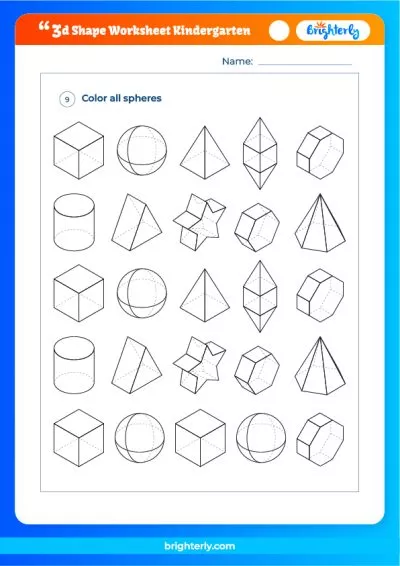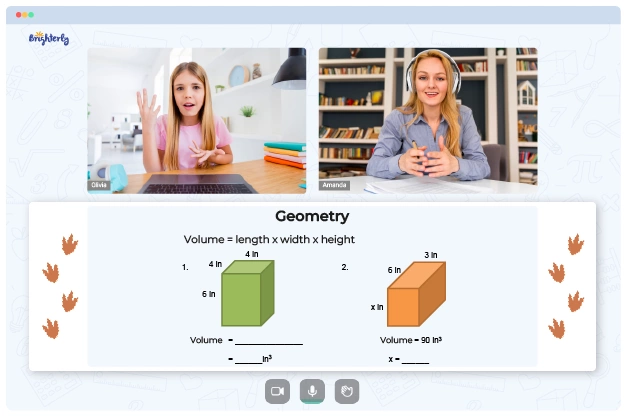Three Dimensional Shapes (3D Shapes)
Updated on January 7, 2024
Welcome to the fascinating world of three-dimensional shapes! At Brighterly, we are committed to providing engaging and comprehensive content that will not only ignite your child’s curiosity but also lay the foundation for a bright future in mathematics. This article will explore the amazing properties and applications of 3D shapes, an essential part of geometry, and provide fun and interactive learning opportunities for children of all ages.
What Are Three Dimensional Shapes?
Three-dimensional shapes, also known as 3D shapes, are objects with length, width, and height. Unlike two-dimensional shapes, which are flat and have only two dimensions, 3D shapes have depth and occupy space in the real world. They are a fundamental part of geometry and are extensively used in various fields such as architecture, engineering, and design. In this article, we will explore the properties of 3D shapes, their classifications, and some practical applications for children at Brighterly.
Faces, Edges, and Vertices of Three Dimensional Shapes
The primary components of 3D shapes are faces, edges, and vertices. Faces are the flat surfaces that make up the shape, edges are the lines where two faces meet, and vertices are the points where three or more edges meet. Understanding these components is crucial for grasping the basic properties of various 3D shapes and how they relate to one another.
To deepen your comprehension of 3D shapes, we recommend exploring the range of math worksheets offered by Brighterly. These worksheets have been meticulously crafted to assist you in learning and strengthening your knowledge of this topic.
List of Three-dimensional Shapes
Dive into the fascinating world of three-dimensional shapes with this expanded list. Each shape has its unique properties and applications that make them exciting to explore. At Brighterly, we encourage children to learn about these shapes through hands-on experiences and interactive lessons, fostering a love for mathematics and a strong understanding of geometry.
Cube
A cube is a symmetrical 3D shape with six identical square faces. It has 12 edges and 8 vertices, with each vertex connecting three edges. All angles in a cube are right angles, and all faces are perpendicular to one another. Cubes are frequently found in everyday objects such as dice, Rubik’s cubes, and building blocks.
Cuboid
A cuboid, also known as a rectangular prism, is a 3D shape with six rectangular faces. It has 12 edges and 8 vertices, similar to a cube. However, unlike a cube, the faces of a cuboid can have different dimensions, resulting in a more diverse range of shapes. Common examples of cuboids include shoeboxes, bricks, and books.
Prism
A prism is a versatile 3D shape with two congruent, parallel bases connected by rectangular faces. The bases can be any polygon, such as triangles, rectangles, or hexagons, resulting in a wide variety of prisms. Examples of prisms include triangular prisms (like a Toblerone chocolate bar) and hexagonal prisms (like a pencil).
Pyramid
A pyramid is a captivating 3D shape characterized by a polygon base and triangular faces that meet at a common vertex, known as the apex. The number of faces in a pyramid corresponds to the number of sides in the base polygon. Pyramids can have various base shapes, such as triangular, square, or pentagonal, making them an intriguing subject of study in geometry.
Cylinder
A cylinder is a 3D shape with two parallel, congruent circular bases connected by a smooth, curved surface. The height of the cylinder is the distance between the two bases. Cylinders are commonly found in everyday objects such as cans, tubes, and columns in architecture.
Cone
A cone is a 3D shape with a circular base and a curved surface that tapers smoothly to a single point, known as the apex or vertex. The height of the cone is the distance from the base to the apex. Cones are prevalent in both natural and man-made objects, such as party hats, ice cream cones, and pinecones.
Sphere
A sphere is a perfectly symmetrical 3D shape with a smooth, curved surface. All points on the surface are equidistant from the central point, known as the center. Spheres are abundant in nature and human-made objects, ranging from planets and balls to water droplets and bubbles.
By learning about these diverse three-dimensional shapes and their properties, children at Brighterly can develop a deep understanding of geometry and its real-world applications, nurturing a lifelong love for mathematics.
Conclusion
In conclusion, three-dimensional shapes are crucial in helping us make sense of the world we live in. By exploring and understanding these shapes, children at Brighterly can build their spatial reasoning skills and appreciate the beauty and intricacies of the geometric world around them. As they progress in their mathematical journey, they will be able to apply their knowledge of 3D shapes to tackle complex problems in various fields, such as architecture, engineering, and design.
Brighterly is dedicated to fostering a love for learning in every child. We believe that through hands-on activities, interactive lessons, and engaging content, children can develop a strong foundation in mathematics and confidently navigate the world of three-dimensional shapes. By learning about 3D shapes and their properties, children are empowered to think critically, solve problems, and, most importantly, have fun while doing so! So let your child’s imagination soar and embark on an exciting adventure into the realm of 3D shapes with Brighterly.
Frequently Asked Questions of Three Dimensional Shapes
What is the difference between 2D shapes and 3D shapes?
2D shapes have only two dimensions, length and width, and exist on a flat plane. They have no depth and are often represented on paper or screens. Examples of 2D shapes include squares, circles, and triangles.
3D shapes, on the other hand, have three dimensions, length, width, and height. They occupy space in the real world and can be physically touched and manipulated. Examples of 3D shapes include cubes, spheres, and cylinders. Learning about 3D shapes at Brighterly enables children to enhance their spatial awareness and better understand the world around them.
What are the main components of a 3D shape?
The main components of a 3D shape are faces, edges, and vertices.
-
Faces are the flat or curved surfaces that make up the shape. They can be polygons (such as squares, triangles, or rectangles) or curved surfaces (such as those found in cylinders or spheres).
-
Edges are the lines where two faces meet. They can be straight, as in polyhedra (solid shapes with flat faces), or curved, as in some other 3D shapes like cylinders or cones.
-
Vertices are the points where three or more edges meet. In polyhedra, vertices are the corner points, while in other 3D shapes like cones, the apex is considered a vertex.
Understanding these components helps children at Brighterly identify and analyze different 3D shapes, enabling them to solve various problems related to geometry.
How can I identify a 3D shape?
To identify a 3D shape, consider the following aspects:
-
Examine its faces: Look at the shape and the number of faces. Are the faces flat polygons or curved surfaces? Identifying the faces will help you narrow down the type of 3D shape.
-
Count the edges and vertices: Determine the number of edges and vertices in the shape. This information, combined with the type of faces, can help you classify the 3D shape accurately.
-
Analyze the angles: Observe the angles formed between the faces, especially in polyhedra. This information can provide additional insight into the shape’s properties and classification.
At Brighterly, we provide interactive lessons and activities to help children identify and explore various 3D shapes, fostering a deep understanding of geometry and its real-world applications.
Information Sources
- Wikipedia: Three-dimensional space
- National Council of Teachers of Mathematics: Geometry and Spatial Sense
- Wolfram MathWorld: Three-Dimensional Geometry
To further explore the world of 3D shapes and enhance your understanding, check out these websites and resources.






